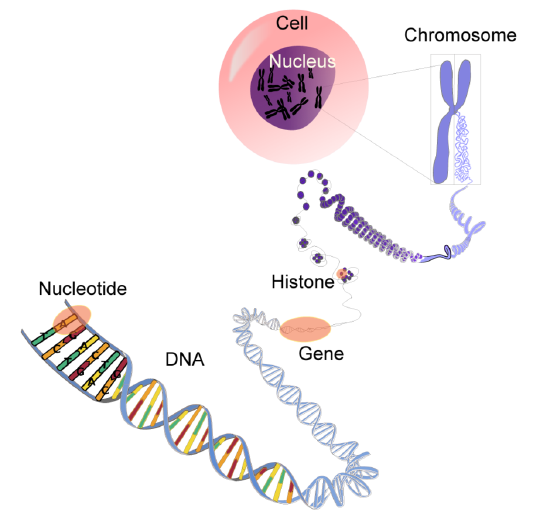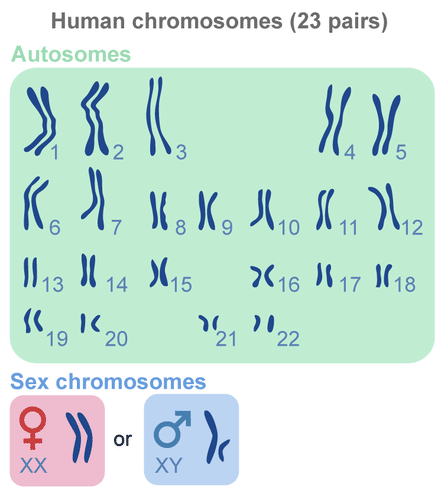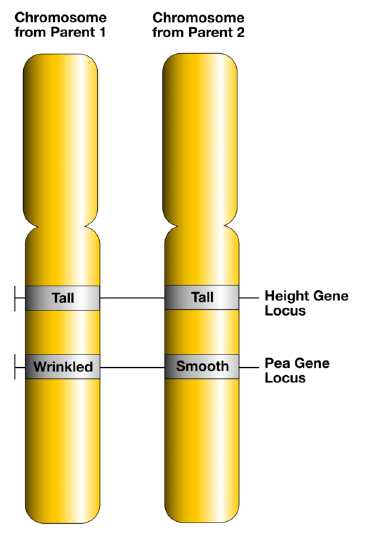10.3: Genetics of Inheritance
- Page ID
- 92630
\( \newcommand{\vecs}[1]{\overset { \scriptstyle \rightharpoonup} {\mathbf{#1}} } \)
\( \newcommand{\vecd}[1]{\overset{-\!-\!\rightharpoonup}{\vphantom{a}\smash {#1}}} \)
\( \newcommand{\dsum}{\displaystyle\sum\limits} \)
\( \newcommand{\dint}{\displaystyle\int\limits} \)
\( \newcommand{\dlim}{\displaystyle\lim\limits} \)
\( \newcommand{\id}{\mathrm{id}}\) \( \newcommand{\Span}{\mathrm{span}}\)
( \newcommand{\kernel}{\mathrm{null}\,}\) \( \newcommand{\range}{\mathrm{range}\,}\)
\( \newcommand{\RealPart}{\mathrm{Re}}\) \( \newcommand{\ImaginaryPart}{\mathrm{Im}}\)
\( \newcommand{\Argument}{\mathrm{Arg}}\) \( \newcommand{\norm}[1]{\| #1 \|}\)
\( \newcommand{\inner}[2]{\langle #1, #2 \rangle}\)
\( \newcommand{\Span}{\mathrm{span}}\)
\( \newcommand{\id}{\mathrm{id}}\)
\( \newcommand{\Span}{\mathrm{span}}\)
\( \newcommand{\kernel}{\mathrm{null}\,}\)
\( \newcommand{\range}{\mathrm{range}\,}\)
\( \newcommand{\RealPart}{\mathrm{Re}}\)
\( \newcommand{\ImaginaryPart}{\mathrm{Im}}\)
\( \newcommand{\Argument}{\mathrm{Arg}}\)
\( \newcommand{\norm}[1]{\| #1 \|}\)
\( \newcommand{\inner}[2]{\langle #1, #2 \rangle}\)
\( \newcommand{\Span}{\mathrm{span}}\) \( \newcommand{\AA}{\unicode[.8,0]{x212B}}\)
\( \newcommand{\vectorA}[1]{\vec{#1}} % arrow\)
\( \newcommand{\vectorAt}[1]{\vec{\text{#1}}} % arrow\)
\( \newcommand{\vectorB}[1]{\overset { \scriptstyle \rightharpoonup} {\mathbf{#1}} } \)
\( \newcommand{\vectorC}[1]{\textbf{#1}} \)
\( \newcommand{\vectorD}[1]{\overrightarrow{#1}} \)
\( \newcommand{\vectorDt}[1]{\overrightarrow{\text{#1}}} \)
\( \newcommand{\vectE}[1]{\overset{-\!-\!\rightharpoonup}{\vphantom{a}\smash{\mathbf {#1}}}} \)
\( \newcommand{\vecs}[1]{\overset { \scriptstyle \rightharpoonup} {\mathbf{#1}} } \)
\( \newcommand{\vecd}[1]{\overset{-\!-\!\rightharpoonup}{\vphantom{a}\smash {#1}}} \)
\(\newcommand{\avec}{\mathbf a}\) \(\newcommand{\bvec}{\mathbf b}\) \(\newcommand{\cvec}{\mathbf c}\) \(\newcommand{\dvec}{\mathbf d}\) \(\newcommand{\dtil}{\widetilde{\mathbf d}}\) \(\newcommand{\evec}{\mathbf e}\) \(\newcommand{\fvec}{\mathbf f}\) \(\newcommand{\nvec}{\mathbf n}\) \(\newcommand{\pvec}{\mathbf p}\) \(\newcommand{\qvec}{\mathbf q}\) \(\newcommand{\svec}{\mathbf s}\) \(\newcommand{\tvec}{\mathbf t}\) \(\newcommand{\uvec}{\mathbf u}\) \(\newcommand{\vvec}{\mathbf v}\) \(\newcommand{\wvec}{\mathbf w}\) \(\newcommand{\xvec}{\mathbf x}\) \(\newcommand{\yvec}{\mathbf y}\) \(\newcommand{\zvec}{\mathbf z}\) \(\newcommand{\rvec}{\mathbf r}\) \(\newcommand{\mvec}{\mathbf m}\) \(\newcommand{\zerovec}{\mathbf 0}\) \(\newcommand{\onevec}{\mathbf 1}\) \(\newcommand{\real}{\mathbb R}\) \(\newcommand{\twovec}[2]{\left[\begin{array}{r}#1 \\ #2 \end{array}\right]}\) \(\newcommand{\ctwovec}[2]{\left[\begin{array}{c}#1 \\ #2 \end{array}\right]}\) \(\newcommand{\threevec}[3]{\left[\begin{array}{r}#1 \\ #2 \\ #3 \end{array}\right]}\) \(\newcommand{\cthreevec}[3]{\left[\begin{array}{c}#1 \\ #2 \\ #3 \end{array}\right]}\) \(\newcommand{\fourvec}[4]{\left[\begin{array}{r}#1 \\ #2 \\ #3 \\ #4 \end{array}\right]}\) \(\newcommand{\cfourvec}[4]{\left[\begin{array}{c}#1 \\ #2 \\ #3 \\ #4 \end{array}\right]}\) \(\newcommand{\fivevec}[5]{\left[\begin{array}{r}#1 \\ #2 \\ #3 \\ #4 \\ #5 \\ \end{array}\right]}\) \(\newcommand{\cfivevec}[5]{\left[\begin{array}{c}#1 \\ #2 \\ #3 \\ #4 \\ #5 \\ \end{array}\right]}\) \(\newcommand{\mattwo}[4]{\left[\begin{array}{rr}#1 \amp #2 \\ #3 \amp #4 \\ \end{array}\right]}\) \(\newcommand{\laspan}[1]{\text{Span}\{#1\}}\) \(\newcommand{\bcal}{\cal B}\) \(\newcommand{\ccal}{\cal C}\) \(\newcommand{\scal}{\cal S}\) \(\newcommand{\wcal}{\cal W}\) \(\newcommand{\ecal}{\cal E}\) \(\newcommand{\coords}[2]{\left\{#1\right\}_{#2}}\) \(\newcommand{\gray}[1]{\color{gray}{#1}}\) \(\newcommand{\lgray}[1]{\color{lightgray}{#1}}\) \(\newcommand{\rank}{\operatorname{rank}}\) \(\newcommand{\row}{\text{Row}}\) \(\newcommand{\col}{\text{Col}}\) \(\renewcommand{\row}{\text{Row}}\) \(\newcommand{\nul}{\text{Nul}}\) \(\newcommand{\var}{\text{Var}}\) \(\newcommand{\corr}{\text{corr}}\) \(\newcommand{\len}[1]{\left|#1\right|}\) \(\newcommand{\bbar}{\overline{\bvec}}\) \(\newcommand{\bhat}{\widehat{\bvec}}\) \(\newcommand{\bperp}{\bvec^\perp}\) \(\newcommand{\xhat}{\widehat{\xvec}}\) \(\newcommand{\vhat}{\widehat{\vvec}}\) \(\newcommand{\uhat}{\widehat{\uvec}}\) \(\newcommand{\what}{\widehat{\wvec}}\) \(\newcommand{\Sighat}{\widehat{\Sigma}}\) \(\newcommand{\lt}{<}\) \(\newcommand{\gt}{>}\) \(\newcommand{\amp}{&}\) \(\definecolor{fillinmathshade}{gray}{0.9}\)This father-son duo is serving in the army together. The shape of their faces and their facial features look very similar. If you saw them together, you might well guess that they are father and son. People have long known that the characteristics of living things are similar in parents and their offspring. However, it wasn’t until the experiments of Gregor Mendel that scientists understood how traits are inherited by offspring.

The Father of Genetics
Mendel did experiments with pea plants to show how traits such as seed shape and flower color are inherited. Based on his research, he developed his two well-known laws of inheritance: the law of segregation and the law of independent assortment. When Mendel died in 1884, his work was still virtually unknown. In 1900, three other researchers working independently came to the same conclusions that Mendel had drawn almost half a century earlier. Only then was Mendel's work rediscovered.
Mendel knew nothing about genes. They were discovered after his death. However, he did think that some type of "factors" controlled traits and were passed from parents to offspring. We now call these "factors" genes. Mendel's laws of inheritance, now expressed in terms of genes, form the basis of genetics, the science of heredity. For this reason, Mendel is often called the father of genetics.
The Language of Genetics
Today, we know that the traits of organisms are controlled by genes on chromosomes. To talk about inheritance in terms of genes and chromosomes, you need to know the language of genetics. Figure \(\PageIndex{2}\) shows the location of genes in a eukaryotic cell. The nucleus is a membrane-enclosed organelle found in most eukaryotic cells. The nucleus is the largest organelle in the cell and contains chromosomes which make up most of the cell's genetic information. Mitochondria also contain DNA, called mitochondrial DNA, but it makes up just a small percentage of the cell’s overall DNA content. The genetic information, which contains the information for the structure and function of the organism, is found encoded in DNA in the form of genes.


A gene is a short segment of DNA that contains information to encode an RNA molecule or a protein strand. DNA in the nucleus is organized in long linear strands that are attached to different proteins. These proteins help the DNA coil up for better storage in the nucleus. Think about how a string gets tightly coiled up if you twist one end while holding the other end. These long strands of coiled-up DNA and proteins are called chromosomes.
Each chromosome contains many genes. The function of the nucleus is to maintain the integrity of these genes and to control the activities of the cell by regulating gene expression. Gene expression is the process by which the information in a gene is "decoded" by various cell molecules to produce a functional gene product, such as a protein molecule or an RNA molecule. The human species is characterized by 23 pairs of chromosomes (Figure \(\PageIndex{3}\)).
Autosomes
Of the 23 pairs of human chromosomes, 22 pairs are autosomes (the lines numbered 1–22 in Figure \(\PageIndex{3}\)). Autosomes are chromosomes that contain genes for characteristics that are unrelated to sex. These chromosomes are the same in males and females. The great majority of human genes are located on autosomes. The genes located on these chromosomes are called autosomal genes.
Sex Chromosomes
The remaining pair of human chromosomes consists of the sex chromosomes, X and Y. Females have two X chromosomes, and males have one X and one Y chromosome. In females, one of the X chromosomes in each cell is inactivated and known as a Barr body. This ensures that females, like males, have only one functioning copy of the X chromosome in each cell.
As you can see from Figure \(\PageIndex{3}\), the X chromosome is much larger than the Y chromosome. The X chromosome has about 2,000 genes, whereas the Y chromosome has fewer than 100, none of which are essential to survival. (For comparison, the smallest autosome, chromosome 22, has over 500 genes.) Virtually all of the X chromosome genes are unrelated to sex. The genes located on the X chromosomes are called X-linked genes. Only the Y chromosome contains genes that determine sex. A single Y chromosome gene, called SRY (which stands for sex-determining region Y gene), triggers an embryo to develop into a male. Without a Y chromosome, an individual develops into a female, so you can think of a female as the default sex of the human species. Can you think of a reason why the Y chromosome is so much smaller than the X chromosome?

Figure \(\PageIndex{4}\): Chromosome, Gene (for height and pea gene), Locus, and Allele (tall, wrinkled, or smooth). This diagram shows how the concepts of the chromosome, gene, locus, and allele are related. These terms are defined below
The following terms are a good starting point. They are illustrated in Figure \(\PageIndex{4}\) that follows.
- A gene is the part of a chromosome that contains the genetic code for a given protein. For example, in pea plants, a given gene might code for flower color.
- The position of a given gene on a chromosome is called its locus (plural, loci). For example, a gene might be located near the center or at one end or the other of a chromosome.
- A given gene may have different normal versions called alleles. For example, in pea plants, there is a smooth seed allele (S) and a wrinkled seed allele (s) for the seed shape gene. Different alleles account for much of the variation in the traits of organisms including people.
- In sexually reproducing organisms, each individual has two copies of each type of chromosome. Paired chromosomes of the same type are called homologous chromosomes. They are about the same size and shape, and they have all the same genes at the same loci.
Genotype
When sexual reproduction occurs, sex cells called gametes unite during fertilization to form a single cell called a zygote. The zygote inherits two of each type of chromosome, with one chromosome of each type coming from the sperm donor and the other coming from the egg donor. Because homologous chromosomes have the same genes at the same loci, each individual also inherits two copies of each gene. The two copies may be the same allele or different alleles. The alleles an individual inherits for a given gene make up the individual’s genotype. As shown in the table below, an organism with two of the same allele (for example, BB or bb) is called a homozygote. An organism with two different alleles (in this example, Bb) is called a heterozygote.
| Alleles | Genotypes | Phenotypes |
|---|---|---|
| BB (homozygous dominant) | purple flowers | |
| B (purple) | Bb (heterozygous) | purple flowers |
| b (white) | bb (homozygous recessive) | white flowers |
Phenotype
The expression of an organism’s genotype is referred to as its phenotype. The phenotype refers to the organism’s traits, such as purple or white flowers in pea plants. As you can see from Table \(\PageIndex{1}\), different genotypes may produce the same phenotype. In this example, both BB and Bb genotypes produce plants with the same phenotype, purple flowers. Why does this happen? In a Bb heterozygote, both alleles are expressed but only the B allele is seen in phenotype because it masks the expression of b, so the b allele doesn’t influence the phenotype. The allele B is called dominant, and the allele that doesn't show in the phenotype is called recessive.
The terms dominant and recessive may also be used to refer to phenotypic traits. For example, purple flower color in pea plants is a dominant trait. It shows up in the phenotype whenever a plant inherits even one dominant allele for the trait. Similarly, white flower color is a recessive trait. Like other recessive traits, it shows up in the phenotype only when a plant inherits two recessive alleles for the trait.
Review
- Define genetics.
- Why is Gregor Mendel sometimes called the father of genetics if genes were not discovered until after his death?
- Correctly use the terms gene, allele, locus, and chromosome in one or more sentences.
- Compare and contrast genotype and phenotype.
- Imagine that there are two alleles, R and r, for a given gene. R is dominant to r. Answer the following questions about this gene.
- What are the possible homozygous and heterozygous genotypes?
- Which genotype or genotypes express the dominant R phenotype? Explain your answer.
- Are R and r on different loci? Why or why not?
- Can R and r be on the same exact chromosome? Why or why not? If not, where are they located?
- If a child has the genotype Dd and inherited the D from their mother, where did the d likely come from?
- Either their mother or their father
- Their father
- Their maternal grandmother
- Their maternal grandfather
- True or False. Each phenotype has only one genotype.
- True or False. Recessive genes are never expressed in a phenotype.
- True or False. An observable physical trait is a phenotype.
- A gene for flower color and a gene for seed shape could be on the same:
- chromosome
- locus
- allele
- Both A and B
- What does a gene usually codes for?
Explore More
Attributions
- Father and son by Sgt. Tracy Ellingsen, public domain
- DNA terminology by Wa-Su Biology, dedicated CC0 via Wikimedia Commons
- Chromosomes by Mariana Ruiz Villarreal (LadyofHats), CC BY-NC 3.0, for CK-12
- Gene loci and allele by Keith Chan, CC BY-SA 4.0 via Wikimedia Commons
- Text adapted from Human Biology by CK-12 licensed CC BY-NC 3.0


